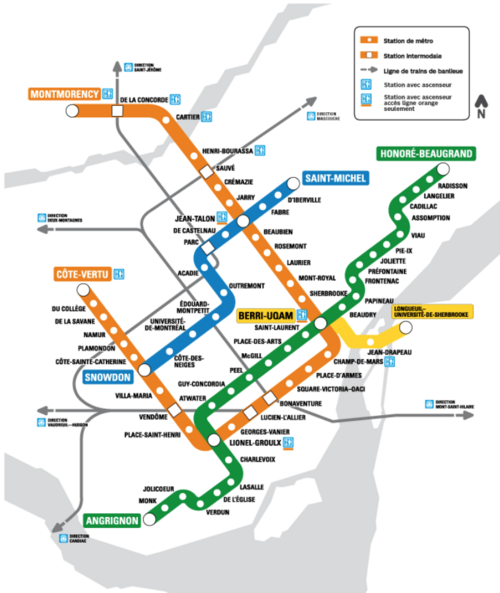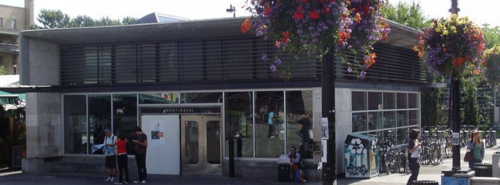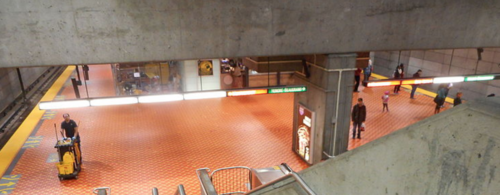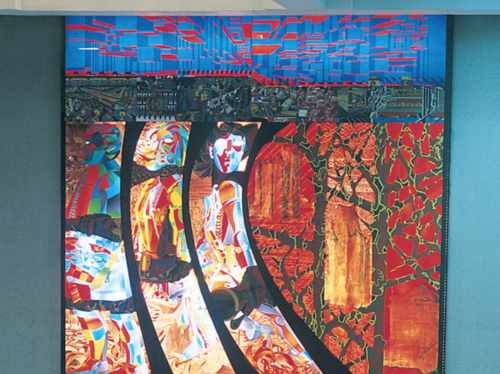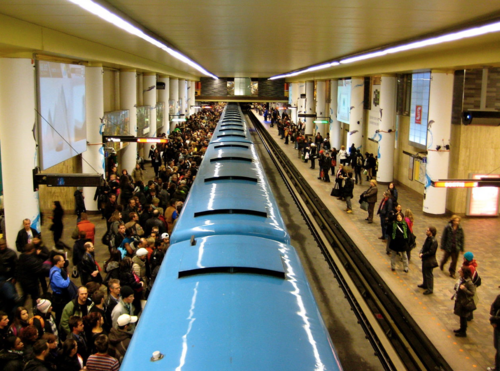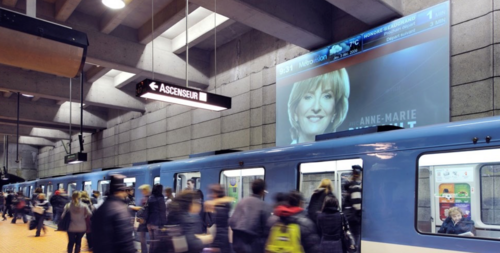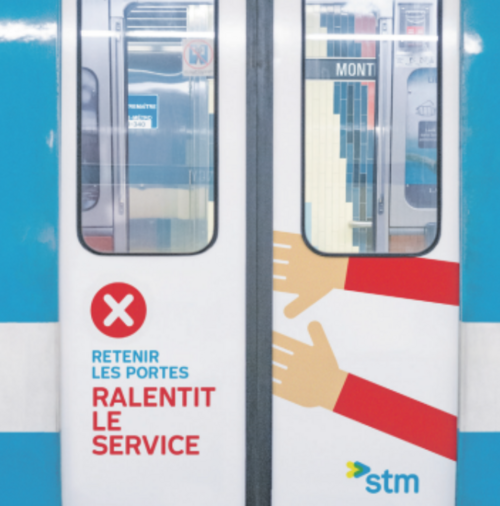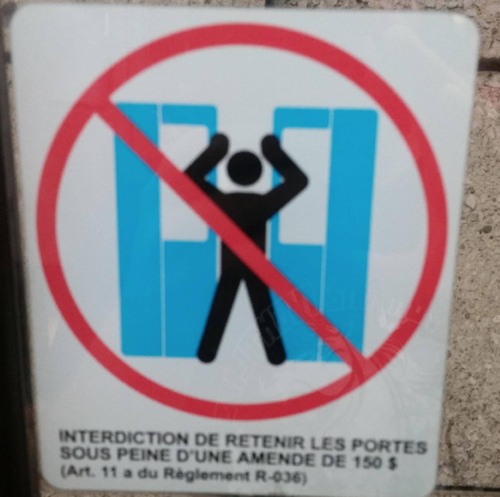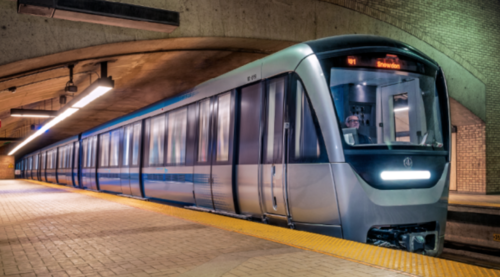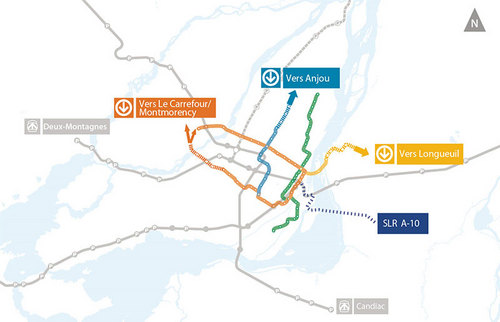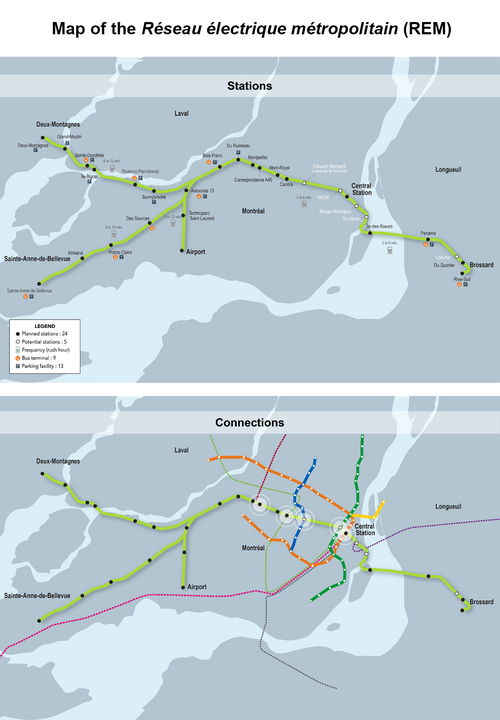Check out Montreal’s transit network
In Montreal, the subway system has video screens that display more than just train arrival times, and stations double as art galleries. Thanks to low-cost measures like these, commuting in Montreal is a world-class experience.
Montreal has a subway called the the Société de transport de Montréal (STM) and a central train station called Gare Centrale, which is fed by six Agence métropolitaine de transport (AMT) regional rail lines and long distance rail (Via Rail and Amtrak), and an extensive network of traditional bus, electric bus and long distance bus.
There is also a central bus station, Gare d’autocars de Montréal, located adjacent to Berri-UQAM (a Metro transfer station where the Orange, Green and Yellow lines intersect), from which several of the local bus lines (including the 747 to the Montreal airport (YUL)) and the regional and long distance bus services originate/terminate.
STM’s stations are a bit more lively than Metro’s
Montreal subway stations vary widely in terms of design. At Station Lionel-Goulx, for example, which opened in 1978, DC riders feel at home because the orange-red tile and cement walls are reminiscent of the brutalist FBI building. But beyond that, STM stations are distinct from anything you’d find in the DC system in a number of ways.
The differences often begin right at the entrance. Given Montreal’s northern location, the entrances to the city’s subway are butterfly/diner-style doors that hinge at the middle— these protect against the elements, and are easy to open despite the changes in air pressure thanks to trains coming and going below.
The most obvious difference is in the central convenience store, Couche-Tard, located in the center of the platform. Couche-Tard is a regional chain, much like 7-11. Imagine a miniature 7-11 in the center platform of the lower level of Metro Center.
Another obvious difference are the platform stickers indicating where to stand while waiting for passengers to exit from the train that is found at nearly every station.
In Montreal’s view, stations don’t gave to be grey
The Montreal metro views itself as an art gallery and takes its stewardship responsibility seriously. The STM partners with Art Public Montreal to increase awareness of Montreal as an international public art destination, and artwork is literally incorporated into station designs. Here, you can see stained glass incorporated into the walls at Champ-de-Mars:
Another example of stained glass in station design, this time at Berri-UQAM:
But it’s not just the art that brightens up the space, it is the actual design of the stations themselves. Below is Station McGill, near McGill University. Notice the white columns, lighter materials used in the walls and ceilings, and, perhaps most strikingly, the video projector displays:
Less glamorous measures also help the system run smoothly
Metrovision, a private company run in conjunction with STM, first appeared in the Montreal system in 2004. It uses LCD display screens and video projectors to show news, weather, the time, and train arrivals.
Montreal’s subway also has older displays similar to Metro’s PIDs, which simply show the next arrival time. The Metrovision displays, however, could teach WMATA a thing or two about about communicating with riders, along with how to make some additional revenue in the process.
After finding that more than half of the more than 1,000 delays in 2012 were caused by passenger actions, including holding open doors or pulling the emergency brake upon missing their stop, Montreal beefed up its enforcement of the law that says people can’t keep a train from departing.
Every train door has a sticker warning passengers that blocking the door when it is closing is a criminal offense, punishable by a fine of up to $500.
There are also signs reminding people to be polite riders:
Take a look at Montreal’s hardware
Recently, like Metro, STM began receiving new train cars. Theirs are called Azur. Montreal’s system is a bit different from Metro in that the trains consist of nine-linked cars trains that use rubber tires. The new Azur cars have full width walkways between cars, which increases the capacity of each train by 8%.
The 747 is a bus line linking Trudeau Airport running through downtown to the Gare de Autocars de Montreal. It runs 24 hours a day, typically every 10-15 minutes during peak travel times, taking about 45-60 minutes to arrive downtown depending on highway traffic.
The 747 is limited stop, stopping on major cross streets downtown near hotels. Busses are equipped with wi-fi and the $10 fare includes an unlimited 24 hour day pass that you can use throughout the STM system.
Montreal is getting some important new rail projects
Five new stations are planned for the east end of the STM’s Blue Line, a move that’s likely to add an additional 80,000 new daily riders to the system. Prime Minister Justin Trudeau, who ascended to the Liberal Party leader as a Member of Parliament representing a riding (Congressional District) in Montreal, has promised to fund the extension, estimated to cost $1.8 billion.
The extension would add an additional 5.5 kilometers to the system. This is no Silver Line— it would go in dense urban neighborhoods and would serve an area desperately in need of additional transit options.
Montreal is also getting a new light rail system. On April 22, the Caisse de depot et placement du Quebec, a pension management Crown corporation, proposed building a new $5 billion light rail system which would connect the transit-neglected West Island, North Shore, South Shore and the Montreal Trudeau Airport with downtown Montreal.
The new system would be fully automated, extend 67 kilometers and encompass 24 new stations.

